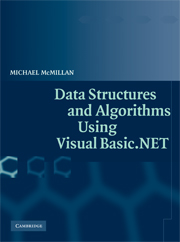Book contents
- Frontmatter
- Contents
- Preface
- Introduction
- Chapter 1 Collections
- Chapter 2 Arrays and ArrayLists
- Chapter 3 Basic Sorting Algorithms
- Chapter 4 Basic Searching Algorithms
- Chapter 5 Stacks and Queues
- Chapter 6 The BitArray Class
- Chapter 7 Strings, the String Class, and the StringBuilder Class
- Chapter 8 Pattern Matching and Text Processing
- Chapter 9 Building Dictionaries: The DictionaryBase Class and the SortedList Class
- Chapter 10 Hashing and the HashTable Class
- Chapter 11 Linked Lists
- Chapter 12 Binary Trees and Binary Search Trees
- Chapter 13 Sets
- Chapter 14 Advanced Sorting Algorithms
- Chapter 15 Advanced Data Structures and Algorithms for Searching
- Chapter 16 Graphs and Graph Algorithms
- Chapter 17 Advanced Algorithms
- References
- Index
Chapter 12 - Binary Trees and Binary Search Trees
Published online by Cambridge University Press: 11 August 2009
- Frontmatter
- Contents
- Preface
- Introduction
- Chapter 1 Collections
- Chapter 2 Arrays and ArrayLists
- Chapter 3 Basic Sorting Algorithms
- Chapter 4 Basic Searching Algorithms
- Chapter 5 Stacks and Queues
- Chapter 6 The BitArray Class
- Chapter 7 Strings, the String Class, and the StringBuilder Class
- Chapter 8 Pattern Matching and Text Processing
- Chapter 9 Building Dictionaries: The DictionaryBase Class and the SortedList Class
- Chapter 10 Hashing and the HashTable Class
- Chapter 11 Linked Lists
- Chapter 12 Binary Trees and Binary Search Trees
- Chapter 13 Sets
- Chapter 14 Advanced Sorting Algorithms
- Chapter 15 Advanced Data Structures and Algorithms for Searching
- Chapter 16 Graphs and Graph Algorithms
- Chapter 17 Advanced Algorithms
- References
- Index
Summary
Trees constitute a very common data structure in computer science. A tree is a nonlinear data structure that is used to store data in a hierarchical manner. We examine one primary tree structure in this chapter, the binary tree, along with one implementation of the binary tree, the binary search tree. Binary trees are often chosen over more fundamental structures, such as arrays and linked lists, because you can search a binary tree quickly (as opposed to a linked list) and you can quickly insert data and delete data from a binary tree (as opposed to an array).
DEFINITION OF A TREE
Before we examine the structure and behavior of the binary tree, we need to define what we mean by a tree. A tree is a set of nodes connected by edges. An example of a tree is a company's organization chart (see Figure 12.1).
The purpose of an organization chart is to communicate to the viewer the structure of the organization. In Figure 12.1, each box is a node and the lines connecting the boxes are the edges. The nodes, obviously, represent the entities (people) that make up an organization. The edges represent relationships among the entities. For example, the CIO (Chief Information Officer) reports directly to the CEO (Chief Executive Officer), so there is an edge between these two nodes. The Development Manager reports to the CIO, so there is an edge connecting them.
- Type
- Chapter
- Information
- Data Structures and Algorithms Using Visual Basic.NET , pp. 249 - 267Publisher: Cambridge University PressPrint publication year: 2005



